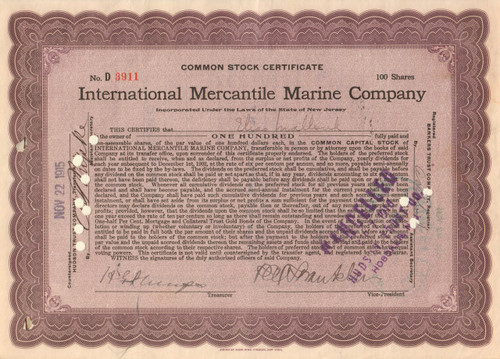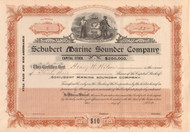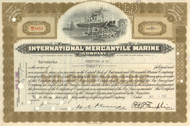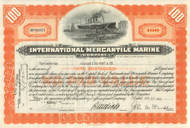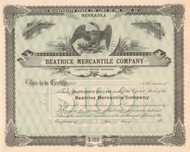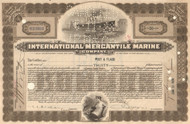Categories
Categories
International Mercantile Marine Company (Titanic) plain certificate
Product Description
International Mercantile Marine Company stock certificate (Titanic) plain style
Uncommon Titanic collectible. This IMM piece is the plain issuance for common stock. Issued and unissued available (see pictures). Dated 1915 for issued examples.
RMS Titanic was a British passenger liner that sank in the North Atlantic Ocean in the early morning of 15 April 1912 after colliding with an iceberg during her maiden voyage from Southampton, UK, to New York City, US. The sinking resulted in the deaths of more than 1,500 passengers and crew, making it one of the deadliest commercial peacetime maritime disasters in modern history. The RMS Titanic, the largest ship afloat at the time it entered service, was the second of three Olympic class ocean liners operated by the White Star Line, and was built by the Harland and Wolff shipyard in Belfast with Thomas Andrews as her naval architect. Andrews was among those who died in the sinking. On her maiden voyage, she carried 2,224 passengers and crew. The 1997 movie "Titanic" was nominated for 14 Oscars, winning 11 awards. With an initial worldwide gross of over $1.84 billion, Titanic was the first film to reach the billion-dollar mark and the highest grossing film to date.
The International Mercantile Marine Co., originally the International Navigation Company, was a trust formed in the early twentieth century as an attempt by J.P. Morgan to monopolize the shipping trade. The result was heavy losses for Morgan.
IMM was founded by shipping magnates Clement Griscom of the American Line and Red Star Line, Bernard N. Baker of the Atlantic Transport Line, J. Bruce Ismay of the White Star Line, and John Ellerman of the Leyland Line. The Dominion Line was also amalgamated. The project was bankrolled by J.P. Morgan & Co., led by financier J. P. Morgan. The company also had working profit-sharing relationships with the German Hamburg-Amerika and the North German Lloyd lines. The trust caused great concern in the British shipping industry and led directly to the British government's subsidy of the Cunard Line's new ships RMS Lusitania and RMS Mauretania in an effort to compete. However, IMM dramatically overpaid to acquire some of the amalgamated companies, due to overestimation of potential profits.
IMM was a holding company that controlled subsidiary corporations that had their own subsidiaries. Morgan hoped to dominate transatlantic shipping through interlocking directorates and contractual arrangements with the railroads, but that proved impossible because of the nature of sea transport, American antitrust legislation, and an agreement with the British government. One of IMM's subsidiaries was the White Star Line, which owned the RMS Titanic.
Analysis of financial records shows that IMM was overleveraged and suffered from inadequate cash flow that caused it to default on bond interest payments in late 1914. As a result, a "friendly" receivership was put in effect in 1915, which allowed IMM to reorganize its finances; it emerged from the receivership in 1916. Saved by World War I, IMM eventually reemerged as the United States Lines, which itself went bankrupt in 1986.
The early 1910s marked a turning point for the IMM. Indeed, on April 15, 1912, the Titanic, flagship of its fleet, sank during her maiden voyage. Besides the financial and human losses, the sinking had repercussions on the organization of the trust. Through the American commission of inquiry devoted to the sinking, Senator William Alden Smith openly attacked the very principle of the company and Morgan. As had been arranged before Titanic sank, J. Bruce Ismay retired as president of IMM in 1913 and was succeeded by Harold Sanderson and Morgan died on March 31, 1913. After the 1915-16 receivership, Sanderson was succeeded as president by Franklin, who had been the receiver.
However, the sinking of the Titanic did not bring about the end of the IMM. Although theoretically powerful due to its continued influence with some of the top American, British, and German shipping companies, the overseeing company never managed to overcome its own financial problems, nor dominate the bulk of the North Atlantic shipping trade, and was therefore not as successful as expected. The company went into receivership in 1915 and was placed in the hands of Franklin, who managed to save it. In the late 1920s, he received grants from the government to American ships and in 1926 it sold the White Star Line to the Royal Mail Steam Packet Co. for £7 million, of which £2.35 million was still unpaid when the Royal Mail Group, which was overleveraged and undercapitalized, collapsed in the early 1930s. In 1930, IMM possessed 30 vessels. There were 19 in 1933 and only 11 by 1935.
The ailing company merged with the Roosevelt Steamship Company, parent company of the Roosevelt Line in 1931 to form Roosevelt International Mercantile Marine Company (RIMM). Later in 1931, RIMM acquired the financially troubled United States Lines and began consolidating its operations under that brand. The Atlantic Transport Line was dissolved in late 1931 and its ships were distributed throughout RIMM's remaining divisions. The American Line was merged into United States Lines in 1932, the Red Star Line was sold to Arnold Bernstein in 1934, Baltimore Mail Line merged into United States Lines in 1937, the Panama Pacific Line was dissolved in 1938 and its ships divested, and American Merchant Line was merged into United States Lines in 1938.
Finally, the Roosevelt Line was merged into United States Lines in 1940, leaving that company as RIMM's only remaining business. RIMM changed its name to United States Lines Inc. in 1943, recasting itself as a smaller company focused exclusively on transatlantic routes under a single brand.
 Loading... Please wait...
Loading... Please wait... 
